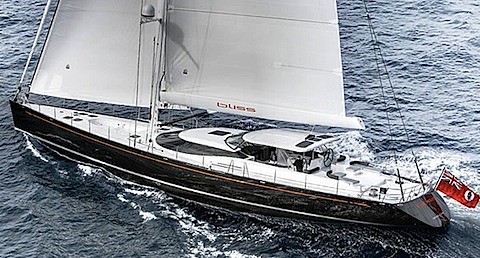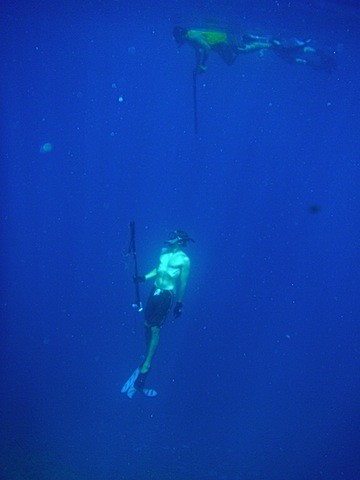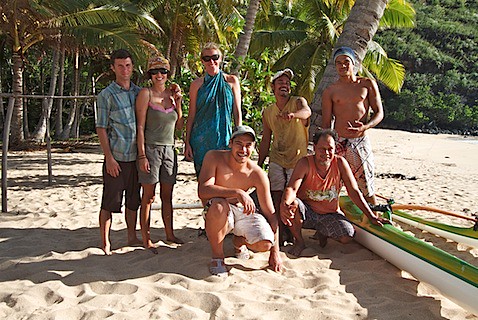We left Tahanea just after sunset on June 17th. We weren't thrilled with leaving through the pass in the dark but we'd been through it a couple of times already and it seemed to be a pretty mellow pass and the just-after-sunset slack current period worked out better for timing the entrance to Fakarava's south pass than the much earlier slack current period. Shalimar went out ahead of us and we saw them buck around a bit. When our turn came we also did a bit of bouncing and splashing but we made it out just fine. After a pretty mellow and uneventful overnight passage we got to the south Fakarava pass early on the morning of the 18th and a couple of hours before the slack current (despite our efforts to reduce sail and slow down during the trip) so we hove to and prepared wait for slack current time. As we were waiting, Christine saw another boat enter the pass with no problem so we decided to approach more closely and check it out. Everything looked fine so we entered the pass and, aside from a bit of opposing current, it was a piece of cake. Once inside, we followed some waypoints we'd gotten from other boats around some shallow areas and over to the anchorage just west of the pass.
There were quite a few other boats already anchored and among them was a catamaran named Changing Spots. We'd met Rob and Cynthia in Nuku Hiva and he'd told us then that he was a retired physician so I was glad to see them in the anchorage. By this point the backs of both my hands were swollen, reddish-purple, covered with little blister like bumps, painful, and quite itchy. I still wasn't sure if the rash was being caused by antibiotic induced sun sensitivity or by a resurgence of bacteria. Consequently, I didn't know if I should keep taking the antibiotic. I got Rob on the radio and he generously offered to stop by our boat and take a look at my mitts. He told me he thought it was the sun-sensitivity-antibiotic thing and advised me to quit the Doxycycline and keep my hands out of the sun (I'd already been trying to keep them out of the sun but that's easier said than done down here). I was happy to stop taking the damned Doxycycline because it tended to make me a bit nauseous anyway and I looked forward to a speedy recovery.
Unfortunately, the recovery was not as speedy as I might have liked. I spent the next two days holed up in the cabin of the boat gulping down pain killers and rubbing various creams on the backs of my hands. Not only was it inconvenient to do stuff outside while trying to constantly wear gloves (they tend to cut down on manual dexterity and can get a bit warm in the sun) but, by this time, it also hurt to close my hands all the way. Christine went ashore a couple of times with Ryan and Alex from Shalimar and snorkeling with some other folks in between taking care of me and listening to me complain so those two days weren't a complete loss for her. By the 21st, I was finally starting to feel a bit better so Christine, Ryan, Alex, and I piled into our dinghy and went over to the south pass to snorkel and check out the mostly abandoned village. I, of course, made sure to wear my gloves the whole time.
The south pass was beautiful for snorkeling. There was tons of coral and, because we went near slack current, there was just a gentle current sweeping us into the lagoon. Alex does not like being in the water with sharks so she stayed topside in the dinghy while the rest of us swam around her. Given her feelings about sharks, it was probably a good choice for her. There were lots of 'em. Most of them were the black tip reef shark variety but there were a few white tip reef sharks and grey sharks thrown in as well. All of the sharks were quite mellow and well behaved. They sometimes came fairly close but didn't seem particularly interested in us. They were just going about their primitive business and occasionally looking at us with their blank beady eyes. The coral at the edge of the pass started just below the surface and sloped down steeply to about 50 or 60 feet so we just followed along the wall until the current let up. Where the current let up, there was a dock and tons of pretty reef fish to look at so we tied up the dinghy and snorkeled around there for a while longer.
After snorkeling we wandered around on land for a while and checked out the depopulated village. There were a couple of small hotels, a restaurant, a dive shop, and a couple of other things still in use but there were also a ton of abandoned buildings with missing roofs and weeds growing through what used to be the floor. I'd like to tell you the whole story of why the village was abandoned by its residents but I never found out. The typical story in the Tuamotus is that a village gets destroyed by a hurricane and is then abandoned for a while. We were interested in diving the south pass but the dive shop guy happened to be taking the week off so we had to save our diving money for the north pass.
On the 22nd we raised our anchor at about 9am and Shalimar was right in front of us. We motored through the sketchy shallow area and, once we made it to the charted and marked channel area inside the lagoon, we raised the sails, killed the engine, and headed northeast to get to the smooth water in the lee of the eastern edge of the atoll. With the wind chop and the glare from the sun in front of us, we were grateful for the channel markers and the relatively accurate soundings on our electronic charts. We still kept up a lookout for shallow coral heads but it's a lot more relaxing when you have at least some idea of what to expect.
By the afternoon we'd made it about halfway up the approximately 30 nautical mile lagoon and decided to anchor close to the shore where we'd be protected from the wind chop and even some of the wind (there was a thick stand of really tall palm trees along the apparently uninhabited shore). The ground didn't hold the anchor too well and sloped pretty steeply offshore but after the second attempt we felt secure enough to spend the night. We all went ashore briefly to check out the coral rubble beach. Then Christine and I went over to visit Shalimar who had anchored right next to us.
In the morning we raised our anchors, got back into the channel and headed up to Rotoava. Rotoava is the main village where most of the atoll's population of around 700 lives. On the way up there we got surprised by a nasty squall that jumped out at us from the other side of the palm trees. We suddenly found ourselves in about 30 knots of wind with driving rain and near zero visibility. Fortunately, the reef and the ring of land protected us from the swell and our chartplotter and depth sounder kept us safely in the channel and the whole thing was over in a few minutes.
When we pulled into the anchorage, we had a nice surprise waiting for us. Our friends on Tuatara were there! We hung out with Kevin a lot in Mexico both before and after Evelyn joined him as crew and we left for the Marquesas on the same day but, because Tuatara doesn't have a long range radio, we hadn't talked to them since. We had heard from other boats that had seen them that they'd had a 40+ day passage compared to our 29 days so we knew they'd made it across but were never sure when we'd see them again.
The next few days included some catching up with Kevin and Evelyn and some really expensive but necessary re-provisioning but the highlight was diving the north pass. We were hesitant to spend the money (it was about $100 US per person) but Fakarava is a world renowned scuba diving destination so we figured we had to do it. The attraction is a drift dive with tons of sharks through the pass. Given that the dive takes you down to around 100 ft, the pass is over 5 miles from the anchorage, and that the current can really get strong out there, we had decided that just renting tanks and attempting the dive on our own was out of the question. Ryan (from Shalimar), Christine, and I did the dive and we all agreed that it was worth the expense.
We lucked out that the trip we booked with Te Ava Nui consisted of just the three of us, the dive guide from the shop, and three other divers. That's a fairly small group for these commercial operations. We lucked out even further that the three other divers ended up being quite competent. On these kind of dives it only takes one bad diver to screw things up, make the guide nervous, and cut the dive short for everyone. We were all loaded into a fast rigid bottomed inflatable boat about 25 ft long. After a short trip out to the pass, we put on our gear, rolled into the water, and descended immediately. As soon as you get in the water, the current is moving you so, if you want to hit the bottom in a particular spot, you can't waste any time. At first, there was nothing but blue water below us. At around twenty or thirty feet, a shelf of live coral at about 100 feet became visible. The shelf sloped gradually up toward the inside of the lagoon and down very steeply toward the outside. As we descended toward our landing spot at the 100 foot mark, large shapes moved slowly around us in the water column and eventually became sharks. There were lots of them - mostly black tipped and grey reef sharks.
We were all pretty intent on reaching our landing spot on the shelf but I spared a few seconds to turn around and look at the sharks circling around the outside of the pass. I saw two that were significantly larger than the rest and, after squinting at them for a second, realized they were hammerheads. I knew how much Christine wanted to see hammerheads so I forced myself to turn away, chase down her and Ryan, and gesture about what I'd just seen. Unfortunately, by the time I'd done all this, the hammerheads were too far away to see.
Once we hit the bottom, we all hunkered down and found bits of dead coral to hang onto. Here, on the edge of the shelf, we held ourselves face into the current and watched the sharks mill around in the water column above us. There were lots. It's hard to say how many filed past in the 5 to 10 minutes we spent there but there must have been at least 100. When the guide gave us the signal, we let go of our handholds and were swept along the reef at quite a clip. No swimming necessary (except to steer). After zooming over a couple of gentle coral hills and valleys, we dropped into a canyon and steered into a little sand bowl in the bottom of another coral valley. By staying close to the bottom, we were able to duck out of the current like you'd hide from the wind on land. We spent the next 30 minutes or so in a couple of these little sand bowls checking out the reef that surrounded us on all sides. There were fish of all shapes and sizes milling about in large shoals and, of course, more sharks. The sharks, as usual, ignored the awkward mammalian intruders but there, out of the current, we were able to get much closer to them. At one point, Christine moved away from the rest of the divers out to the edge of our little sandy area to photograph a group of 10 or 15 grey sharks there were hanging out together. I looked over and noticed her on her own out there just as the group of sharks started moving closer to her. I don't think they were interested in Christine, they just happened to have something to do in the area right next to her. Within a couple of second Christine was much closer to sharks that she was to people so I swam over to give her some company. After a decent sized grey shark swam about 3 feet in front of her, she turned around to see how far from the group she was and I think she was glad to see me headed in her direction.
Once the diving was done, it was time to load up on a few final expensive provisions and head off to Toau - our last stop in the Tuamotus. Shalimar followed right behind us and Tuatara a few hours later so we were looking forward to hanging out with our friends in a nice protected anchorage.
Oh yeah, I almost forgot to finish up with the zombie hand saga. The first couple of days anchored near the south pass was the worst of it. By the time we got to Rotoava and the north pass area, the swelling had gone down and the pain and itching had eased off considerably. The backs of my hands remained a bit discolored (splotchy reddish purple) and scaly for a week or so but after a bit of skin peeling they are now as good as ever.










